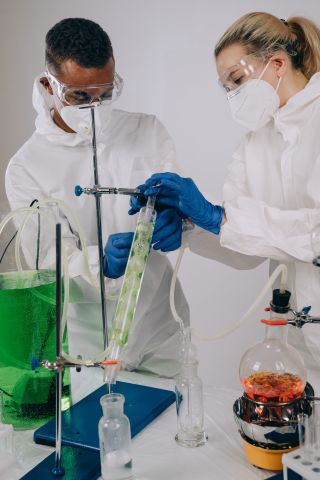Traumatic Brain Injury
New Research Shows Reduced Serotonin in Long COVID
I theorized using neurostimulation to increase low serotonin after brain injury.
Posted October 30, 2023 Reviewed by Gary Drevitch

A recent paper in Cell caught my eye for its original research on serotonin reduction in Long COVID. Wong et al wrote:
“Several hypotheses have been formulated to explain the etiology of PASC [Post-acute sequelae of COVID-19], including viral persistence, chronic inflammation, hypercoagulability, and autonomic dysfunction. Here, we propose a mechanism that links all four hypotheses in a single pathway and provides actionable insights for therapeutic interventions….Viral infection and type I interferon-driven inflammation reduce serotonin through three mechanisms: diminished intestinal absorption of the serotonin precursor tryptophan; platelet hyperactivation and thrombocytopenia, which impacts serotonin storage; and enhanced MAO-mediated serotonin turnover. Peripheral serotonin reduction, in turn, impedes the activity of the vagus nerve and thereby impairs hippocampal responses and memory. These findings provide a possible explanation for neurocognitive symptoms associated with viral persistence in Long COVID, which may extend to other post-viral syndromes.”
In 2010, I theorized that diminished serotonin in my hypothalamus arising from brain injury was behind some of my debilitating symptoms. My health care providers noted my low vagal tone as well. I hypothesized that increasing serotonin, concomitant with seasonal variations, may reverse my symptoms.
Following is an adapted excerpt from Concussion Is Brain Injury: Treating the Neurons and Me (2017 revised edition):
“I left the pituitary endocrinologist’s office finished with evidence-based medicine. She’d noticed the water bloating my features and taught me about cortisol testing, but she didn’t know much about the hypothalamus, that tiny brain part that controls the pituitary. The best she could offer was monitoring. Monitoring! Screw it! I’ll fix myself!
Over the next two months, I tugged old knowledge out of isolated memory banks and clung to it long enough to read up about the hypothalamus, over and over. I thought about my AVE [audiovisual entrainment] and, at the end of July, began an email conversation with Dave Siever at Mind Alive about closed head injury, the hypothalamus, cranioelectrical stimulation (CES), and AVE. My internal magma machine reminded me to push and push my brain to read, to remember, to understand, to think, and to create a regimen with my AVE and CES devices that would do for me what the doctors refused to do: get my heat down and water out of my face once and for all. By middle of August, I had Mind Alive’s CES device. Three days later, I began working on what would become my hypothalamus fix."
Wong et al investigated why serotonin was low in patients with COVID and Long COVID, their end goal being able to identify therapies that directly address the cause(s) of Long COVID’s neurocognitive symptoms. When I devised my hypothalamus fix, I used my logic and reason to work out a possible underlying cause and my five years of neurostimulation experience to devise a treatment strategy. Today, I think low serotonin isn’t the foundational cause but the result of brain dysfunction and aggressive microglial activation after injury. Rewiring the brain to reverse these changes, including theoretically increasing serotonin in the hypothalamus, was effective in me. I was shocked at how quickly neurostimulation worked.
Turning back to Concussion Is Brain Injury (2012 edition):
“I had been using the CES Sleep [100 Hz] session alternating with the Relief session at various times to see what the effects were. Even though use was not daily or sometimes two or three times a day, depending on pain levels, and variable, by the start of September, I was feeling calmer after each use, and I had also begun dreaming again. On the second morning I began to use the one-hour Sleep session consistently, the edema or water retention started to go down, as evidenced by looser rings, a thinner face, a thinner nose, and being able to feel my bones from my shoulders to my knuckles to my feet. By the third session on, I reduced the morning dose of atenolol (normally 12.5 mg). However, that smaller dose was still too much as it put me to sleep. Overall, night-time sleep was becoming more consistent. By late September, my neck thinned and began to show a normal hollow at the base.
At the end of September, my acupuncturist confirmed that I was significantly less hyperthermic, though still producing some heat. And she noted my mood was elevated; for the first time in over 10 years, I looked happy. She recommended reducing acupuncture frequency….
In October, I had my first hot shower in years; my skin did not react nor did I overheat. Normally, my skin develops hot spots, which turn red and swell up and spread unless I pour cold water on them and moisturize with melaleuca-oil cream. Having a hot shower with no need to cool my skin down was a very big deal.”
Consider Neurostimulation?
I wrote about my hypothesis, methodology, and results behind my permanent improvement in Concussion Is Brain Injury (2017 revised edition). But I couldn’t investigate the cellular mechanism of serotonin depletion. What Wong et al discovered about Long COVID may occur similarly after brain injury. Thus, as other researchers have shown with using neurostimulation for COVID and Long COVID, a novel combination of methods could permanently rewire the brain and heal the gut-brain axis so as to normalize serotonin, melatonin, and other neurotransmitter levels.
Isn’t it time researchers studied how 100 Hz CES and/or AVE can increase tryptophan metabolites in those with Long COVID and brain injury?
Wong et al wrote, “Deviations from homeostatic concentrations of amino acids can exert profound effects on tissue function. While we focused on serotonin in this study, tryptophan serves as the precursor for many other important metabolites, including niacin, NAD, and melatonin.” Meanwhile Wang et al found in a concurrent study that low levels of taurine, another amino acid, "predicted adverse clinical outcomes" after hospitalization for COVID.
With SARSCoV2 affecting at least two amino acids, it's time clinicians looked towards curing viral-caused brain injury with neurostimulation treatments rather than using medications such as SSRIs that mask symptoms of only one reduced metabolite of one amino acid.
Copyright ©2012-2017-2023 Shireen Anne Jeejeebhoy
References
Wong, Andrea C., Devason, Ashwarya S., Umana, Iboro C., et al. (2023.) Serotonin reduction in post-acute sequelae of viral infection. Cell. https://doi.org/10.1016/j.cell.2023.09.013
Shealy, C.N., Cady, R.K., Culver veehoff, D., et al. (1998) Cerebrospinal fluid and plasma neurochemicals: Response to cranial electrical stimulation. J Neuro Orthop Med Surg 18: 94-97.
Marksberry, J. A., & Kirsch, D. L. (2018). Cranial electrotherapy stimulation. In J. J. Magnavita (Ed.), Using technology in mental health practice (pp. 85–100). American Psychological Association. https://doi.org/10.1037/0000085-006
Wang, Kaiming, Khoramjoo, Mobin, Oudit, Gavin Y., et al. (2023.) Sequential multi-omics analysis identifies clinical phenotypes and predictive biomarkers for long COVID. Cell Reports Medicine. https://doi.org/10.1016/j.xcrm.2023.101254


